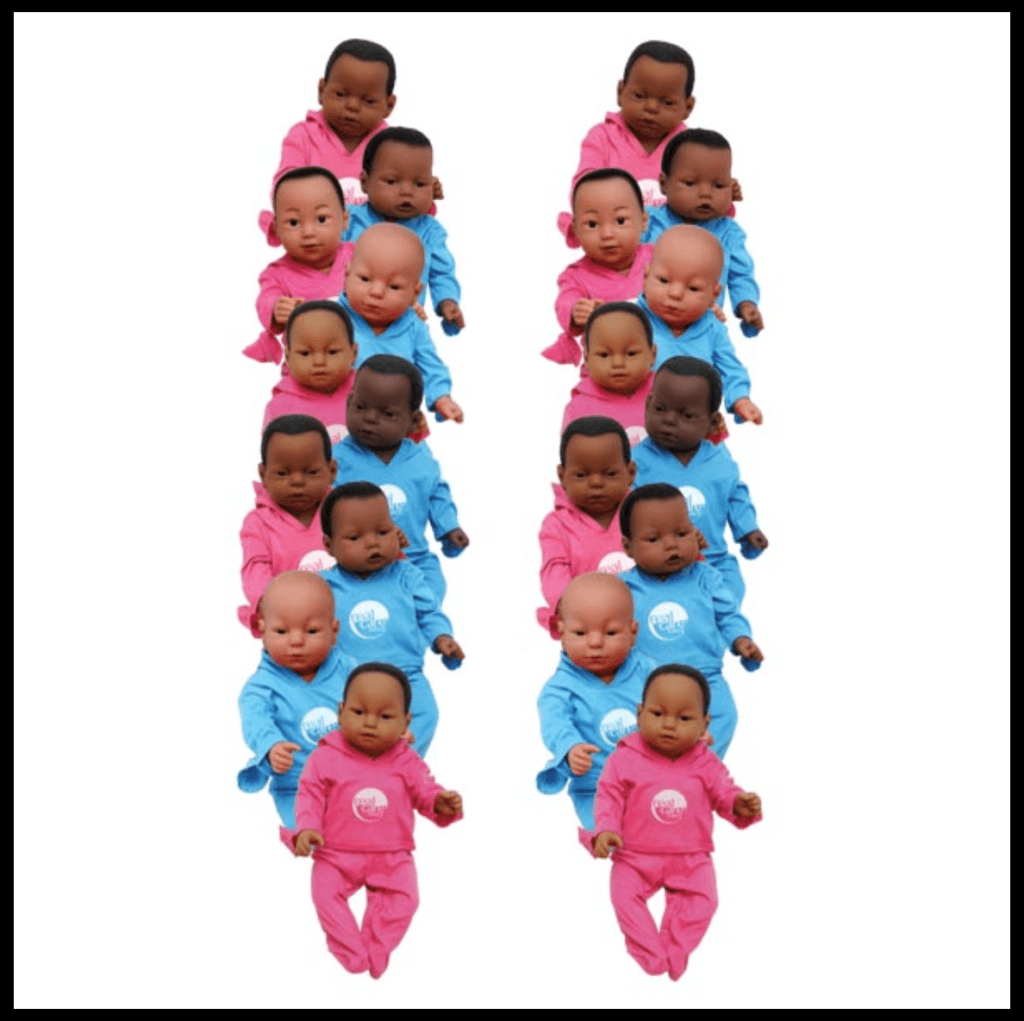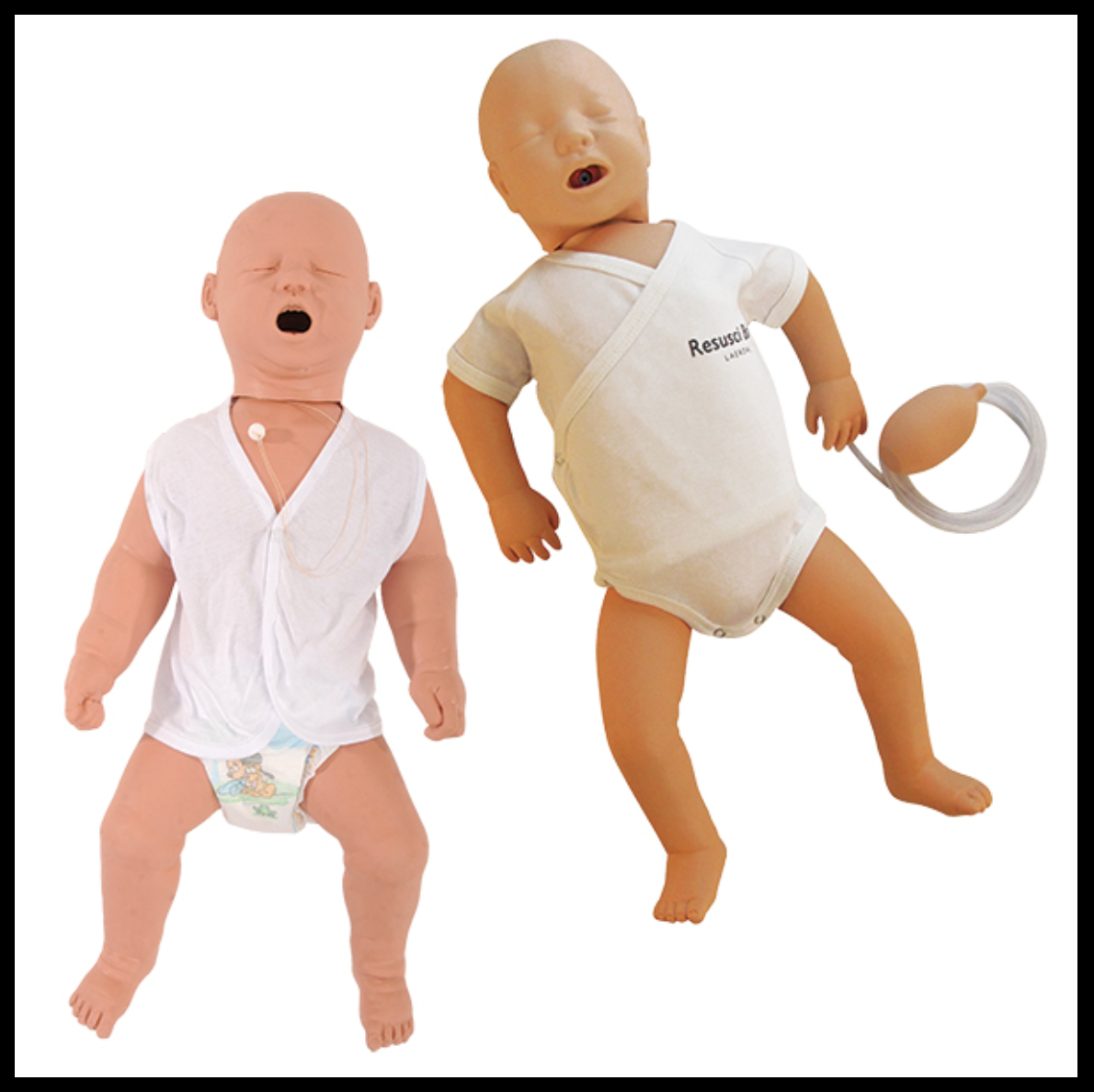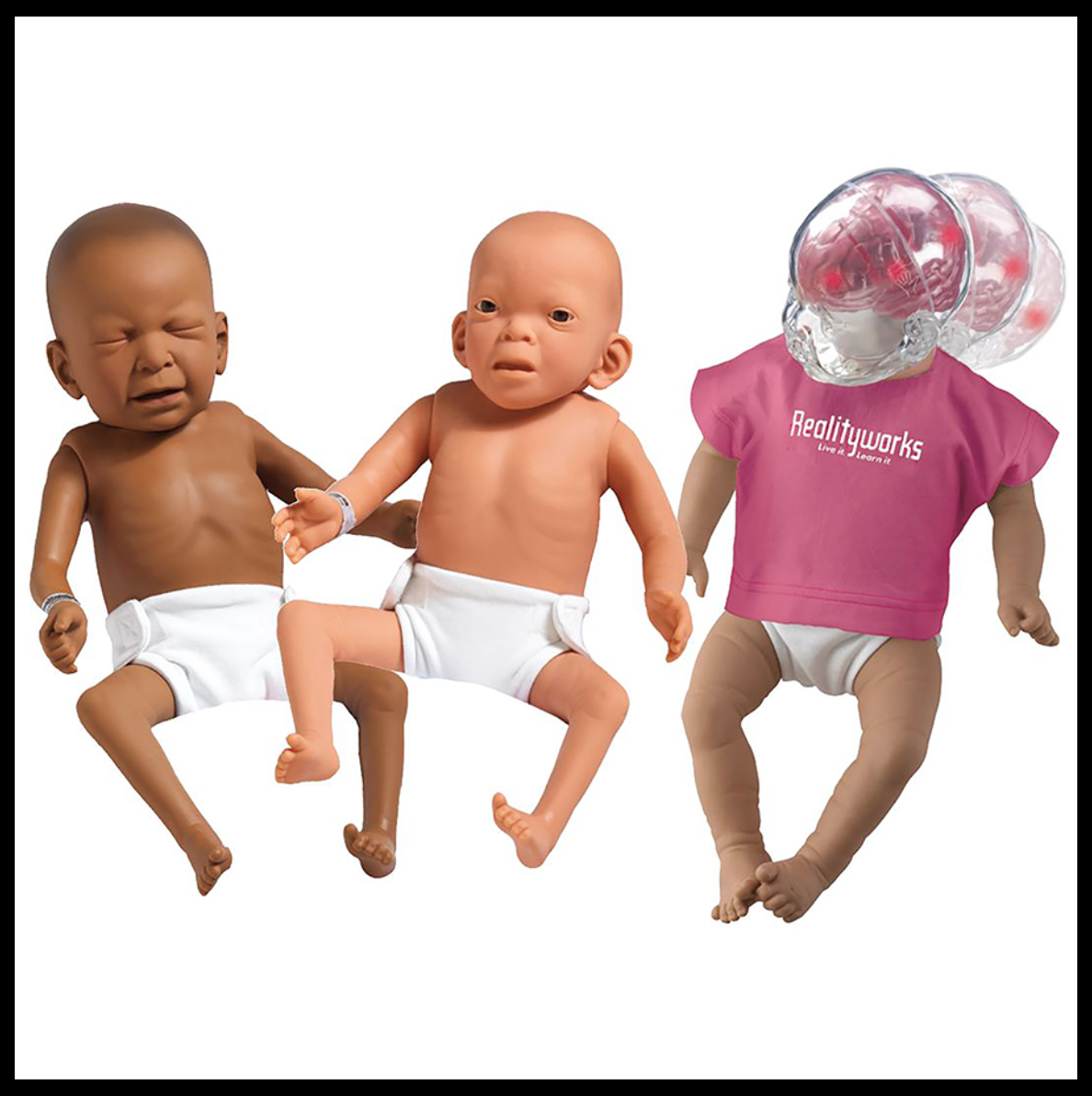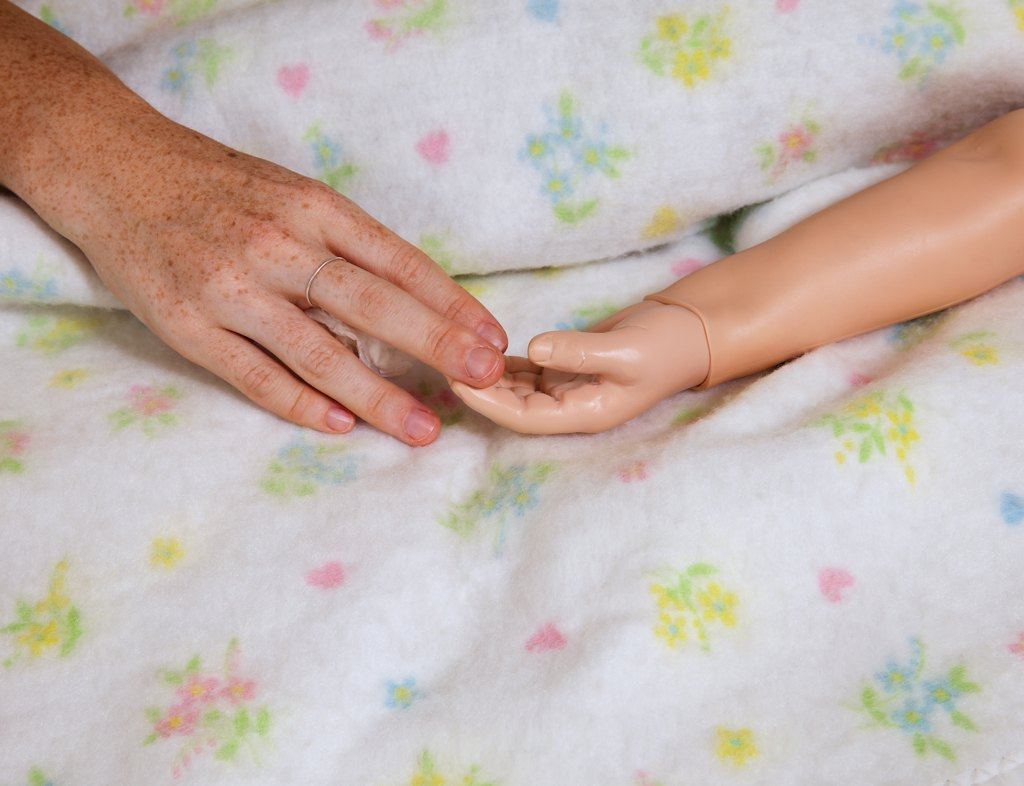The day the Babies arrive is reliably the oddest day of the school year. It’s usually October or February, sometime midway through the semester. One day my juniors and seniors are selling candy at their lockers between classes and getting in trouble for texting, and the next they’re crowding the halls swaddling bundles of plastic joy. One of my students whips out his algebra textbook to use as a changing table in a busy hallway. The homecoming queen rocks a wearable baby carrier fashioned out of a sweatshirt and an alarming amount of duct tape. Synchronized wails in the same pre-programmed voice fill the air.
We’re all at least culturally if not personally familiar with some version of this baby simulation project, whether the baby is an egg, a sack of flour, or a fancy infant simulator like these. Outside of avoiding sharp objects and the rain, however, it doesn’t take much to keep the flour babies alive; the RealCare Baby 3 is another story. Each student wears a wireless ID bracelet that syncs with their infant simulator and which they pass over a sensor in their Baby’s back before responding to its needs. The simulator follows one of 15 different crying schedules, based on those of real infants, each day and night. Some nights it may not cry at all; some nights it may cry over a dozen times. In the quest to quiet their Baby, the student has the option of feeding, burping, changing, or rocking it. They must try to calm their Baby before two minutes have passed to avoid the Baby recording Neglect, which will impact the student’s grade.

RealCare Baby® 3 Infant Simulators
The technology involved is advanced. The bottle must not be propped up into the mouth indefinitely or jammed in too hard. The neck must remain supported. Every year I look forward to the stories my students tell me about the cheats their friends have discovered: how you can keep your Baby’s neck straight without much effort, for example, if you tape a pencil to its head and back. Then there are the accounts of how the Babies have died, so to speak: falling off the bleachers at the homecoming game, getting shaken, getting locked in the trunk of a car. There’s an element of amusement to these stories, but the bare facts disturb: The simulators are, of course, not alive, but at $649 each, they are designed to act like, look like, and sound like actual infants.
If there’s anything I’ve learned from watching my students navigate this activity, it’s just how far it falls short from helping them navigate the challenges that, for many of them, already glaringly exist. As simulators created by adults, the Babies are necessarily encoded with adult biases, and the anxieties they replicate are adult as well. Their technological sophistication is meant to inspire faith in their pedagogical efficacy, but they are a poor substitute for the complicated work of teaching safe-sex education. And they are a wholly inadequate replacement for the more controversial interventional support that many students so desperately need.
The origin of the baby simulation project is tricky to nail down, but according to NPR, the first media mention of the egg baby project appeared in the Philadelphia Inquirer in 1986. At that time, the egg babies were intended to teach care, compassion, and responsibility: they were meant to teach parenting skills, rather than deter kids from becoming parents. British teacher-turned-author Anne Fine wrote the young adult novel Flour Babies, about 6th graders who begrudgingly tackle this project, in 1992, so presumably the flour sacks were incorporated into classrooms before then. In 1993, former NASA engineer Rick Jurmain watched a television program about the project and grew frustrated with the ineffective substitutions. With eggs or sacks of flour, “there’s no crying or waking up at night,” he apparently told his wife Mary, and by the end of the year had created a prototype of the infant simulators we know today.
The Jurmains went on to found the company that manufactures the infant simulators, Realityworks, which now specializes in high-quality training tools for vocational programs including Culinary, Agriculture, Nursing, and Welding. On their website you can order a Multipurpose Venous Training Arm (for practicing injections), a Bovine Breeder™ Artificial Insemination Simulator, or a four-ounce Bottle of Pus. There is also, standing six feet tall and available for $949, a Model Stalk of Corn. The infant simulators are the company’s most popular products, and are readily referred to as Babies; the company has said that they are used in 67 percent of U.S. school districts, as well as in 89 countries worldwide. In my own career as an educator, I have encountered them multiple times, always in health classes as part of a family planning curriculum. They’ve been prevalent in large, urban districts and absent from parochial schools.

RealCare™ Infant Health and Safety Pack
It should go without saying that the Babies are extraordinarily disruptive. One Baby is a lot to handle; working with a classroom full of them is so frustrating there is no time to register the surrealism. During a workshop I’m presenting on how to tell if a college is financially supportive at a time when 70 percent of college students graduate with debt, three of the Babies start to cry so hard my students have to step into the hall. While I’m talking about where to find scholarships, another Baby falls off a student’s lap. I try to talk over it while it shrieks for the requisite full minute before it can be calmed.
The maddening eeriness of this endeavor is that for a few weeks, the high school is indistinguishable from a nursery. My students are stumbling around, utterly detached from any actual obligations, distracted by the dolls in their arms, cooing. Handed children, they are rendered children themselves.
There’s something especially surreal about this scene when the object to be cared for is a Baby. The infant simulators are expensive and sophisticated. They represent just how much money and curriculum and innovation we are willing to devote to replicate the weight of adult responsibilities, and how reluctant we are to recognize the real ones our students often already carry.
According to their website, Realityworks “seek[s] to improve the human condition around the globe by enabling educators to show the probable outcomes of behaviors and choices.” It is unclear whether the goal is to help students learn to care for an infant or to scare students away from having one. “Educators around the world use this unique learning aid to teach early childhood, parenting, infant health lessons, and sex education,” reads the description of the RealCare Baby 3. But the product’s original name was Baby Think It Over — if not a transparent message of deterrence, at least an entreaty to consider very strongly.
The mixed messaging endures in the schools where I’ve worked. In human development classes, the Babies empower students to pursue a career path in which they care for young children, fully acquainted with how difficult those young children can be when they are at their most vulnerable. In health classes, the Babies serve as a clandestine reality check, so that teachers can tell-but-not-tell their students to eschew a path in which they must care for a real, live baby of their own. The idea seems to be that caring for babies as part of a career is acceptable, but caring for one you produced — if you produced it too early, or by accident, or out of wedlock — is not.
Interviewed in 2015 for This American Life, CEO and President Timm Boettcher was adamant that the infant simulator program was not designed to discourage teen pregnancy, but to show teens a more accurate, unvarnished picture of what is like to care for an infant. Research is mixed on whether Realityworks has been successful in this endeavor. A 2006 study using Baby Think It Over showed that the program had a significant impact on teens’ ability to grasp the responsibility involved in caring for an infant. A similar 2011 study revealed that using the infant simulators was only minimally effective in changing teens’ attitudes about pregnancy. In 2016, researchers in Perth, Australia found that 13-to-15-year-old girls who cared for the infant simulators as a component of their health class were six percent more likely to have become pregnant by their 20th birthday, compared to their peers who received the standard health-education curriculum.
The leader of the study, Dr. Sally Brinkman, said that there was no way to tell whether the infant simulators made the girls more interested in becoming moms — in other words, it would be premature to say that the simulators caused the increased number of pregnancies; they just failed to reduce them. Boettcher insisted that it was impossible to draw any conclusions from the study whatsoever, since the essence of Realityworks’ curriculum lies in the combination of in-class activities with the take-home simulator experience, and the study used a shortened in-class curriculum.
The impact of carrying around these Babies likely has a lot more to do with the smaller ecosystems of schools and classrooms than with the experience Realityworks seeks to provide. States create their own laws and policies around sex education. Currently, only 20 states and D.C. require sex education units to provide information about birth control. Thirty-nine states and D.C. require that abstinence be covered; of those, 29 require that abstinence be stressed. When sex education and HIV information are offered, more states require that programs be age-appropriate than medically accurate. A 2016 study found that between 2011 and 2013, 43 percent of adolescent girls and 57 percent of adolescent boys had not received information about birth control before they had sex for the first time. In this light, the Babies might seem like a way to deter kids from having kids without having to talk to them about how to prevent pregnancy.
Immediately after I finished college, I worked as a college access advisor in the only public high school in the school district with the second-highest birth rate in Rhode Island among girls aged 15-19. It was not a wealthy district; 75 percent of students qualified for free or reduced-cost lunch. RealCare Babies were not in the cards for the child psychology class. The day that the “flour children” were distributed, clad in tiny garden-themed onesies, one of my students came to my office to complete her FAFSA (the financial aid application that awards federal aid). We entered the requisite $0 for the questions about her parents’ assets and their retirement accounts and clicked to the next page.
“Do you think we can go back and discuss what those accounts really mean, actually?” my student asked, smiling tenderly at the fleece-wrapped sack of flour nestled against her collarbone and patting it affectionately on what must have been its back. “I want to plan for Daisy’s future.”
For educators, our teenage students’ more adult obligations are often, frankly, inconvenient. They are obstacles to be hurdled. With our students, we tend to acknowledge these duties in the same breath as we discourage them from — or pity them for — fulfilling them. Sometimes a district will try an initiative for a daycare, or you’ll read an article about a principal who bought a washer-dryer for his kids to clean their uniforms at school. But I have not seen systemic responses that help students in poverty. My students who must hold down a job for 30 hours a week to support their family are chastised when their homework is incomplete or unsatisfactory. If I have a student who is the only one in their family who can read and write, I encourage them to write about it in their scholarship essays. One of my students was consistently late to first period and received an F on her midterm report card: It turned out she was staying home to get her first-grader brother to the bus so her mother, sick with cancer and recovering from surgery, could rest. I offered to accompany her while she explained the situation to her counselor. “We need to come up with a game plan so we can get you back to being a student first,” her counselor said. My student nodded blankly through her tears.
With regard to teenage pregnancy, there is a distinct lack of conclusive research on American teachers’ attitudes. It might be that the stigma of teenage pregnancy is pervasive enough that we assume we already know what teachers think. We’ve produced plenty of research about educators in other countries, however. One study out of the Population Council in New York found that, in Kenya, a school environment that deemphasized disparate gender roles seemed to result in fewer female students having sex as teenagers. Another study, conducted by researchers from Brown University, examined how South African teachers’ attitudes about their students’ sexuality impacted school-based HIV prevention. The teachers who were interviewed tended to focus on the girls’ perceived irresponsibility rather than on concrete prevention methods. My hope is that we American educators are honest enough with ourselves to recognize how familiar all of this rings.
At one high school where I worked in northeast Ohio, my office shared space with the PE storage closet, which is to say it was the PE storage closet. I stepped inside my first day to find a desk, two chairs, an old recliner with a single deflated basketball on the seat, and about 11 Babies resting naked atop the cupboards lining the walls. One senior came in to do his FAFSA with his mother, who brought along her two-year-old son. The toddler wobbled in, babbling, and then caught sight of one Baby, tossed carelessly on the recliner with the wires just barely exposed between its head and its neck. He drooled silently, riveted, and then looked at me with the beginning of fear in his eyes. “IT’S OKAY!” my student and I half-shouted in unison, and while he distracted his brother with a Happy Meal toy, I went over to the recliner and hid the Baby under a pillow.
The uncanny valley, the term first coined in 1970 by robotics professor Masahiro Mori, refers to the dip in our emotional response when we are presented with a figure that exhibits human characteristics but is not quite right. As figures progress along an X-axis of “humanness,” we tend to have more affinity for them: a humanoid robot, with arms and legs, is going to get more of an emotional response from us than an industrial robot, and a puppet that looks incredibly human will also elicit a positive response. But there is a dip where that figure seems to register as barely human, and we will turn away from it. Some researchers describe this process as the uncomfortable “mental switchover” from expecting a figure to be human to suddenly realizing it is not.

RealCare™ Infant Health Trio Package
It’s easy to visualize adolescence as its own uncanny valley, marked by strangeness and defined by what is on either side of its trench. The contour of it, though, is unclear, shaped as it is by biology, psychology, and sociology at the same time. We’ve only recently begun to care about the space between childhood and adulthood at all: The first mention of adolescence as a distinct transitional period came from G. Stanley Hall, the first president of the American Psychological Association, who in 1904 conducted a study concluding that new child labor laws had allowed for a new age for teenagers when, suddenly void of responsibilities, “the vestiges of evil in their nature” could flourish. From there, usage of the word “adolescent” in publications spiked, increasing by more than 14 times before reaching its peak in 1996.
Adults project their own hopes and fears on this murky in-between period — adolescence is either idealized or demonized, often both at the same time, and teens are at once innocent and accountable. Even though the Babies haven’t been proven to do much at all — even though the money and the time could be far better spent on real supports — their job is to comfort adults. In a 2016 piece for the New York Times, a nursing professor described the RealCare Baby 3 program’s popularity: “Adults think it’s fabulous… It’s easier than comprehensive sex ed or access to contraception, which are controversial.”
At another high school in Ohio, T. was the first in her senior class to sign up to meet with me. At that initial meeting, I asked her how her day was going. “Terrible,” she said. She had watched a group of disabled students struggle up the stairs that morning and was incensed that the new school building had no handicapped entrance near the special-ed wing. “Our principal,” she said, “is a son of a sandwich.” The last time I heard from her it was via text, a few weeks after she graduated. “I miscarried last week,” she wrote. “I never felt worse in my life. But I realized I can start college this fall after all so please tell me what I need to do.”
I know, for me, that it’s easier to stop that story halfway through. And it’s easier to write about the baby simulators that my students are carrying in the hallways than it is to write about the real babies that they are carrying to term. It’s easier still to share the story of the time one of my students asked if he should declare the three cents he had in his pocket as an asset on the FAFSA. Or the time eight of my students worked out a plan to text me “Yo ;)” at the very same time for no reason at all. Or the time my students in the culinary program won the Rhode Island state clam chowder competition — beating the affluent, previously crowned coastal town — and when I went to purchase the acclaimed chowder the next morning to eat for lunch, I discovered that they had triumphantly, accidentally eaten all of it by 10:30 a.m. Those stories make sense. They fit the established pattern in which teenagers’ charm is tethered to youthful innocence.
One winter morning my first year on the job, I’m in my office with a senior, E., who’s quiet and looming in a big-teddy-bear kind of way and who just turned 18. He doesn’t often come into my office on his own, but he never ignores the passes I send. We are completing the FAFSA. I interpret the legalese for him as I go: “Do you have any children now, or will you have any children next school year?” I ask. “Do you have anybody in your life you financially support like you would support a child?”
E.’s mother is there, too. I expect her to interject with a single sharp laugh and something like, “You better not,” like the other boys’ mothers always do.
“Oh, he better financially support,” she says instead, an easy smile on her face. “He raises his son in my house but I tell him if it’s your son, it’s your money!” She laughs and pulls a deck of photos from her wallet while E. bows his head shyly. “He just turned two! He just had his birthday party! Want to see?”
I let a beat pass, surprised, and then I take the shiny prints into my hands, all curls and new teeth and birthday cake. I smile. E. beams.
